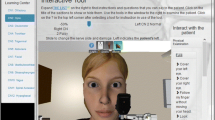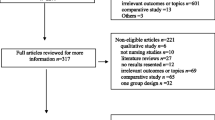Abstract
Systematic reviews and meta-analyses of randomized controlled studies conclude that virtual patient simulations (VPs) are consistently associated with higher learning outcomes compared to other educational methods, such as lectures, handouts, textbooks, and standardized patients (e.g., Consorti et al., Comput Educ 59(3):1001–1008, 2012; Cook and Triola Med Educ 43(4):303–311, 2009; McGaghie et al., Acad Med J Assoc Am Med Colleges 86(6):706, 2011). However, we cannot assume that students will learn by simply giving them access to the simulations. The instructional features that are integrated before, during, and after the simulations may affect student learning as much as or more so than the simulations. The strategy used to integrate the simulation into the curriculum and evaluate student performance may also have a significant effect on its use and learning. Here, we document the design, development, and testing of NERVE (a VPs created to develop medical students’ ability to examine, interview, and diagnose patients with cranial nerve disorders) in one definitive source and elaborate on what went on in each team members’ mind as the system evolved. Specifically, we examine the skills, knowledge, and dispositions called upon and the key lessons learned by team members during the last year of research and development. Concluding remarks related the individual accounts and discuss common findings to shed further insights on the team’s experience.
Similar content being viewed by others
References
Adams, E., Rodgers, C., Harrington, R., Young, M., & Sieber, V. (2011). How we created virtual patient cases for primary care-based learning. Medical Teacher, 33(4), 273–278.
Agency for Healthcare Research and Quality (AHRQ). (2013). PAR-11-024 advances in patient safety through simulation research. http://grants.nih.gov/grants/guide/pa-files/PAR-11-024.html. Accessed January 20.
Atkinson, T., & Hirumi, A. (2010). The game brain. In A. Hirumi (Ed.), Playing games in school: Using simulations and videogames for primary and secondary education (p. 63). Eugene, WA: International Society for Technology in Education.
Bateman, J., Allen, M. E., Kidd, J., Parsons, N., & Davies, D. (2012). Virtual patients design and its effect on clinical reasoning and student experience: A protocol for a randomised factorial multi-centre study. Medical Education, 12(1), 62.
Bateman, J., Allen, M. E., Samani, D., Kidd, J., & Davies, D. (2013). Virtual patient design: Exploring what works and why. A grounded theory study. Medical Education, 47(6), 595–606.
Berman, N., Fall, L., Smith, S., Levine, D., Maloney, C., Potts, M., … Foster-Johnson, L. (2009). Integration strategies for using virtual patients in clinical clerkships. Academic Medicine, 84(7), 943–949.
Botezatu, M., Hult, H., Tessma, M. K., & Fors, U. G. (2010). As time goes by: Stakeholder opinions on the implementation and use of a virtual patient simulation system. Medical Teacher, 32(11), e509–e516.
Cendan, J., & Lok, B. (2012). The use of virtual patients in medical school curricula. Advances in Physiology Education, 36(1), 48–53.
Churchill, D. (2007). Towards a useful classification of learning objects. Educational Technology Research and Development, 55(5), 479–497.
Cobb, P., Confrey, J., diSessa, A., Lehrer, R., & Schauble, L. (2003). Design experiments in educational research. Educational Researcher, 32(1), 9–13.
Colder, B. (2011). Emulation as an integrating principle for cognition. Frontiers in Computational Neuroscience, 5(54), 1–12.
Consorti, F., Mancuso, R., Nocioni, M., & Piccolo, A. (2012). Efficacy of virtual patients in medical education: A meta-analysis of randomized studies. Computers & Education, 59(3), 1001–1008.
Cook, D., & Triola, M. (2009). Virtual patients: A critical literature review and proposed next steps. Medical Education, 43(4), 303–311.
Cook, D. A. (2014). How much evidence does it take? A cumulative meta-analysis of outcomes of simulation-based education. Medical Education, 48(8), 750–760.
Cook, D. A., Erwin, P. J., & Triola, M. M. (2010). Computerized virtual patients in health professions education: A systematic review and meta-analysis. Academic Medicine, 85, 15890–11602.
Cooke, S. F. (2006). Plasticity in the human central nervous system. Brain, 129(Pt 7), 1659–1673.
Dewey, J. (1938). Logic: The theory of inquiry. New York: Holt, Rinehart and Winston.
de Jong, T., & von Joolingen, W. R. (1998). Scientific discovery learning with computer simulations of conceptual domains. Review of Educational Research, 68(3), 179–201.
Edelbring, S. (2010). A three-fold framework for relating to innovations and technology in education: Learning from, with and about technology. In A. Bromage, L. Clouder, J. Thistlethwaite, & F. Gordon (Eds.), Interprofessional E-learning and collaborative work: Practices and technologies (pp. 23–33). Hershey, PA: IGI Global.
Edelbring, S., Broström, O., Henriksson, P., Vassiliou, D., Spaak, J., Dahlgren, L. O., & Zary, N. (2012). Integrating virtual patients into courses: Follow-up seminars and perceived benefit. Medical Education, 46(4), 417–425.
Edelbring, S., Dastmalchi, M., Hult, H., Lundberg, I. E., & Dahlgren, L. O. (2011). Experiencing virtual patients in clinical learning: A phenomenological study. Advances in Health Sciences Education, 16(3), 331–345.
Fischer, M., Hege, I., Hörnlein, A., Puppe, F., Tönshoff, B., & Huwendiek, S. (2007). Virtual patients in medical education: A comparison of various strategies for curricular integration. Zeitschrift fur Evidenz, Fortbildung und Qualitat im Gesundheitswesen, 102(10), 648–653.
Fullan, M. (1993). Change forces: Probing the depth of educational reform. London, UK: Falmer.
Georg, C., & Zary, N. (2014). Web-based virtual patients in nursing education: Development and validation of theory-anchored design and activity models. Journal of Medical Internet Research, 16(4), e105. http://doi.org/10.2196/jmir.2556.
Gibbons, A. S., McConkie, M., Seo, K. K., & Wiley, D. A. (2009). Simulation approach to instruction. In C. M. Reigeluth & A. A. Carr-Chellman (Eds.), Instructional-design theories and models: building a common knowledge base (Vol. III, pp. 167–193). New York, NY: Routledge.
Gormley, G. J., Mcglade, K., Thomson, C., Mcgill, M., & Sun, J. (2011). A virtual surgery in general practice: Evaluation of a novel undergraduate virtual patient learning package. Medical Teacher, 33(10), 522–527.
Haag, M., Singer, R., Bauch, M., Heid, J., Hess, F., & Leven, F. (2007). Challenges and perspectives of computer-assisted instruction in medical education. Lessons learned from seven years of experience with the CAMPUS system. Methods of Information in Medicine, 46(1), 67.
Hall, G. E., & Hord, S. M. (2001). Implementing change: Patterns, principles and potholes. Boston, MA: Allyn and Bacon.
Harden, R. M., Grant, J., Buckley, E. G., & Hart, I. R. (1999). BEME guide no. 1: Best evidence medical education. Medical Teacher, 21(6), 553–562.
Harrison, M., Short, C., & Roberts, C. (2003). Reflecting on reflective learning: The case of geography, earth and environmental sciences. Journal of Geography in Higher Education, 27(2), 133–152.
Hirumi, A., Johnson, K., Kleinsmith, A., Reyes, R., Rivera-Gutierrez, D., Kubovec, S., … Cendan, J. (in press). Advancing virtual patient simulations and experiential learning with InterPLAY: Examining how theory informs design and design informs theory. Journal of Applied Instructional Design.
Hirumi, A., Johnson, T., Reyes, R. J., Lok, B., Johnsen, K., Rivera-Gutierrez, D. J., et al. (2016). Advancing virtual patient simulations through design research and InterPLAY: Part II – testing and integration. Educational Technology, Research & Development. https://doi.org/10.1007/s11423-016-9461-6
Hirumi, A., Kleinsmith, A., Johnsen, K., Kubovec, S., Eakins, M., Bogert, K., et al. (2016). Advancing virtual patient simulations through design research and InterPLAY: Part I – Design and development. Educational Technology, Research & Development, 64(4), 763–785.
Huwendiek, S., & De Leng, B. A. (2010). Virtual patient design and curricular integration evaluation toolkit. Medical Education, 44(5), 519.
Huwendiek, S., De Leng, B. A., Kononowicz, A. A., Kunzmann, R., Muijtjens, A. M., Van Der Vleuten, C. P., … Dolmans, D. H. (2015). Exploring the validity and reliability of a questionnaire for evaluating virtual patient design with a special emphasis on fostering clinical reasoning. Medical Teacher, 37(8), 775–782.
Huwendiek, S., Duncker, C., Reichert, F., De Leng, B. A., Dolmans, D., van der Vleuten, C. P., & Tönshoff, B. (2013). Learner preferences regarding integrating, sequencing and aligning virtual patients with advancing virtual patient simulations through design other activities in the undergraduate medical curriculum: A focus group study. Medical Teacher, 35(11), 920–929.
Huwendiek, S., Reichert, F., Bosse, H. M., De Leng, B. A., Van Der Vleuten, C. P., Haag, M., & Tönshoff, B. (2009). Design principles for virtual patients: A focus group study among students. Medical Education, 43(6), 580–588.
Illeris, K. (2014). Transformative learning and identity. [electronic resource]. Abingdon, Oxon: Routledge.
Issenberg, S. B., McGaghie, W. C., Petrusa, E., Gordon, D. L., & Scalese, R. J. (2005). Features and uses of high-fidelity medical simulations that lead to effective learning: A BEME systematic review. Medical Teacher, 27(1), 10–28.
Johnson, T. R., Lyons, R., Chuah, J., Kooper, R., Lok, B., & Cendan, J. C. (2013). Optimal learning in a virtual patient simulation of cranial nerve palsies: The interaction between social learning context and student aptitude. Medical Teacher, 35(1), 899–907.
Johnson, T. R., Lyons, R., Kooper, R., Johnsen, K. J., Lok, B. C., & Cendan, J. C. (2014). Virtual patient simulations and optimal social learning context: A replication of an aptitude-treatment interaction effect. Medical Teacher, 36(6), 486–494.
Keller, J. M. (1987). Development and use of the ARCS model of instructional design. Journal of instructional development, 10(3), 2–10.
Keller, J. M. (2010). Motivation design for learning and performance: The ARCS model approach. New York: Springer.
Kleinsmith, A., Rivera-Gutierrez, D., Finney, G., Cendan, J. C., & Lok, B. (2015). Understanding empathy training with virtual patients. Computers in Human Behavior, 52, 151–158. http://doi.org/10.1016/j.chb.2015.05.033.
Kononowicz, A. A., Narracott, A. J., Manini, S., Bayley, M. J., Lawford, P. V., McCormack, K., & Zary, N. (2014). A framework for different levels of integration of computational models into web-based virtual patients. Journal of Medical Internet Research, 16(1), e23.
Lindsey, L., & Berger, N. (2009). Experiential approach to instruction. In C. Reigeluth & A. Carr-Chellman (Eds.), Instructional-design theories and models: Volume 3. Building a common knowledge based (pp. 117–142). New York, NY: Routledge.
Maran, N. J., & Glavin, R. J. (2003). Low-to high-fidelity simulation – A continuum of medical education? Medical Education, 37(1), 22–28.
McGaghie, W. C., Issenberg, S. B., Cohen, M. E. R., Barsuk, J. H., & Wayne, D. B. (2011). Does simulation-based medical education with deliberate practice yield better results than traditional clinical education? A meta-analytic comparative review of the evidence. Academic Medicine: Journal of the Association of American Medical Colleges, 86(6), 706.
McKenney, S. E., & Reeves, T. (2012). Conducting educational design research: What, why and how. London, UK: Taylor & Francis Ltd..
Mezirow, J. (1990). Fostering critical reflection in adulthood: A guide to transformative and emancipatory learning. San Francisco. CA: Jossey-Bass.
Moore, F., & Chalk, C. (2009). The essential neurologic examination: What should medical students be taught? Neurology, 72(23), 2020–2023.
Posel, N., Mcgee, J. B., & Fleiszer, D. M. (2014). Twelve tips to support the development of clinical reasoning skills using virtual patient cases. Medical Teacher, 37(9):1–6.
Quinn, C. (2009). Computer-based simulations: Principles of engagement. In M. Silberman (Ed.), The handbook of experiential learning (pp. 138–171). San Francisco, CA: Pfeiffer.
Reigeluth, C. M., & Schwartz, E. (1989). An instructional theory for the design of computer-based simulations. Journal of Computer-Based Instruction, 16(1), 1–10.
Reyes, R. J., & Hirumi, A. (2016). Analyzing the pedagogical foundations of virtual patient simulations: A review of literature. Poster presented at the annual graduate research forum at the University of Central Florida, Orlando, FL, April 5.
Rimmele, U. (n.d.). A primer on emotions and learning. Retrieved May 16, 2017, 2017 OECD. from http://www.oecd.org/edu/ceri/aprimeronemotionsandlearning.htm
Rivera-Gutierrez, D., Kleinsmith, A., Johnson, T., Lyons, R., Cendan, J., & Lok, B. (2014). Towards a reflective practicum of embodied conversational agent experiences, IEEE international conference on advanced learning technologies (ICALT). Athens, Greece: IEEE.
Rogers, E. M., & Rogers, E. M. (2003). Diffusion of innovations. New York, NY: Free Press.
Salas, E., & Gregory, M. E. (2011). Simulation-based training: Beyond the bells and whistles! CyberTherapy Magazine, 4, 18–19.
Salem-Schatz, S., Ordin, D., & Mittman, B. (2010). Guide to the after action review (version 1.1). Using evaluation to improve our work: A resource guide. Retrieved March 23, 2015. http://www.queri.research.va.gov/ciprs/after_action_review.pdf.
Salminen, H., Zary, N., Björklund, K., Toth-Pal, E., & Leanderson, C. (2014). Virtual patients in primary care: Developing a reusable model that fosters reflective practice and clinical reasoning. Journal of Medical Internet Research, 16(1), e3. http://doi.org/10.2196/jmir.2616.
Schank, R. C., Berman, T. R., & Macpherson, K. A. (1999). Learning by doing. In C. M. Reigeluth (Ed.), Instructional-design theories and models: Vol. 2, a new paradigm of instructional theory (pp. 161–181). Mahwah, NJ: Lawrence Erlbaum Associates.
Shank, R. C., Berman, T. R., & Macpherson, K. A. (1992). Learning by doing. In C. M. Reigeluth (Ed.), Instructional design theories and models: A new paradigm of instructional theory (pp. 161–179). Hillsdale, NJ: Lawrence Erlbaum Associates.
Stapleton, C., & Hirumi, A. (2011). InterPLAY instructional strategy: Learning by engaging interactive entertainment conventions. In M. Shaughnessy & S. Fulgham (Eds.), Pedagogical models: The discipline of online teaching (pp. 183–211). Hauppauge, NY: Nova Science Publishers.
Stapleton, C., & Hirumi, A. (2014). Designing InterPLAY learning landscapes to evoke emotions, spark the imagination, and promote creative problem solving. In A. Hirumi (Ed.), Grounded designs for online and hybrid learning (pp. 159–190). Eugene, WA: International Society for Technology in Education.
Acknowledgments
Research reported in chapter paper was supported by the National Institutes of Health (NIH) under award number 1R01LM010813–01. The content is solely the responsibility of the authors and does not necessarily represent the official views of the National Institutes of Health.
Author information
Authors and Affiliations
Corresponding author
Editor information
Editors and Affiliations
Supplementary Electronic Material (S)
(MP4 4075 kb)
(MP4 10302 kb)
Rights and permissions
Copyright information
© 2018 Springer International Publishing AG, part of Springer Nature
About this entry
Cite this entry
Hirumi, A. et al. (2018). NERVE, InterPLAY, and Design-Based Research: Advancing Experiential Learning and the Design of Virtual Patient Simulation. In: Spector, M., Lockee, B., Childress, M. (eds) Learning, Design, and Technology. Springer, Cham. https://doi.org/10.1007/978-3-319-17727-4_76-2
Download citation
DOI: https://doi.org/10.1007/978-3-319-17727-4_76-2
Received:
Accepted:
Published:
Publisher Name: Springer, Cham
Print ISBN: 978-3-319-17727-4
Online ISBN: 978-3-319-17727-4
eBook Packages: Springer Reference EducationReference Module Humanities and Social SciencesReference Module Education
Publish with us
Chapter history
-
Latest
NERVE, InterPLAY, and Design-Based Research: Advancing Experiential Learning and the Design of Virtual Patient Simulation- Published:
- 11 April 2018
DOI: https://doi.org/10.1007/978-3-319-17727-4_76-2
-
Original
NERVE, InterPLAY, and Design-Based Research: Advancing Experiential Learning and the Design of Virtual Patient Simulation- Published:
- 06 October 2017
DOI: https://doi.org/10.1007/978-3-319-17727-4_76-1




